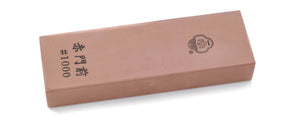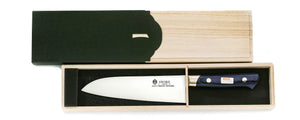Learn about Japanese Knives
Japanese Kitchen Knives offer a world of new possibilities for your culinary journey.
Sakai Ichimonji has developed extensive resources so you can familiarize yourself with knifemaking, sharpening, maintenance and industry jargon. We're always working on new resources too, so please check back often or keep an eye on our newsletters.
Introduction to Knives
Here, we'll introduce you to the basics of kitchen knives, including common steels, knife construction, various knife finishing techniques and more.
Knife Terminology
Here are lists of Japanese and Western knife types and some basic terms. To help you select a knife, it's time to learn the basics!
Left-Handed Knives
Most traditional Japanese knives are "single-edge", with the bevel only on one side. As a result, left-handed knives are very important!
Japanese Handles
Here, we'll cover the various Japanese Style Handles and how crucial it is to replace them when they become worn out.
Whetstone VS Hone
People new to the world of knives often ask if they should use sharpening steel or a whetstone. Find what's best for you here!
Natural Whetstones
Although natural whetstones are produced in small quantities, many use them in search of a finish only obtainable from natural sources.
Knife Maintenance
Sharpening is necessary to maintain quality of your knives. Learn how to sharpen your Japanese knives such as Yanagiba, Deba, and Usuba here.
The "Sun" Measurement
Knives were not always measured in millimeters or inches. Japan traditionally had its own measurement for crafts - a sun unit.
Forged VS Stamped
Kitchen Knives can be produced by only two methods; Stamping or Forging. Both of them have advantages and disadvantages.
Western Handles
Here, we introduce some materials, manufacturing processes and finishes used in Western Style Knife handles.
Cutting Boards
Japanese knives are made from a hard, thin steel and cutting on some boards can damage the blade's edge. Here's our thoughts!
Japanese Swords and Knives
The Japanese sword had its spotlight end with the conclusion Sengoku period. Its craftsmanship continued in Japanese knife-making.
6 Tips of Knife Care
Japanese knives are known for their sharpness and precision. They require special care to maintain their quality. Here's our 6 best tips for upkeep!
Choosing A Whetstone
Sharpening your knives is as important as using them, but there's so many whetstones to pick from! Here's how to buy your first.
What is a Sashimi Knife
There are many types of sashimi knives: Yanagiba, Fugubiki, and Takobiki. This page explains the subtle, yet also big differences!
Knife Making Regions
Japan has a wide variety of knife-making regions. They each have a different area of expertise. Read along to learn more!
Rockwell Hardness
What is Rockwell Hardness? How does it affect a knife? Is blade hardness the most important thing? Learn along with us here!
What Makes A Good Knife?
With thousands of knives on the market at different prices, materials and styles it can be hard to figure out what's good. Let us help!































